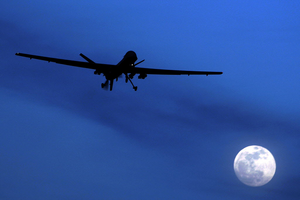In Pakistan, who controls the narrative on drones?
The view that Pakistanis are uniformly opposed to US drone strikes is being questioned by some experts, NGO workers, and locals from Pakistan's tribal belt, where most drone attacks occur.

An unmanned US Predator drone flies over Kandahar Air Field, southern Afghanistan, on a moon-lit night, in 2010.
Kirsty Wigglesworth/AP
Islamabad, Pakistan
As the debate over US drone strikes thrust into the spotlight this week, a trickle of reports from locals, security experts, and non-governmental organization workers in Pakistan’s tribal region suggest that the view of drone strikes within the South Asian nation is more nuanced than its government admits.
Although both Pakistani Prime Minister Nawaz Sharif and US President Barack Obama were expected to downplay the contentious drone policy in their meeting Wednesday, the issue remains a wedge between the two countries and is the subject of a UN hearing Friday.
Sharif’s government has repeatedly called on the US to stop drone strikes that it carries out primarily in the tribal belt, bordering Afghanistan, where terror groups like Al Qaeda are suspected of hiding out. The Pakistani government says the attacks are a violation of its sovereignty and faces immense pressure from political parties who accuse the US of killing innocent victims in the attacks.
Polls about levels of support for drone strikes within the tribal region are notoriously difficult to carry out, but most analyses highlight their deep unpopularity. Mr. Sharif’s US visit coincided with a widely-publicized Amnesty International report on drone strikes in Pakistan, in which the organization highlighted the deaths of at least 29 noncombatants since 2012, and the possibility that more civilians have been killed or injured.
Yet the situation on the ground is much more complex, according to locals and security experts. They say that while the drone attacks are a legal issue for Pakistan and the global community, those residing in the tribal belt do not consider them as unpopular as Pakistani officials portray them to be.
“The locals in Waziristan, where most of the drone strikes happen, actually see them as the only thing saving them from the terrorists since the government has not been taking any action against the elements operating there,” says Nizam Dawar, chairman of the Tribal Development Network, an independent organization that works on peace projects in the tribal belt.
According to Mr. Dawar, who is from North Waziristan, the real narrative never makes it to the mainstream media because of threats from the Taliban.
“While the negative psychological impact of drones flying above one's head maybe true, and I have witnessed that whenever I visit the area, people are more concerned [about] terrorist attacks and the military bombardments since they know the strikes are quite precise and target only those linked with the Taliban,” he says.
“But they cannot talk about that since they live among the Taliban,” Dawar says. "There, it is the rule of ‘see nothing, hear nothing, say nothing'."
Officially, NGOs are not allowed to operate in the Waziristan region due to security concerns. Despite that, Dawar’s organization operates under the radar. For him, most surveys coming out of the tribal region are not the complete truth.
“These surveys that are conducted are usually done by those close to the Taliban, since there is no space to work otherwise," he says. "For example, I recently spoke to Voice of America for perceptions about drone attacks being very divided in the region and the next day the Taliban came outside my home in Waziristan and threatened my family."
Restricted access
Not only is it difficult for organizations to work, journalists from the area also say reporting on drones is a complex issue.
“There are curfews in many of the areas where drone strikes happen, and neither the government nor the military, which controls many of the areas, has any spokesperson willing to talk on this issue,” says Safdar Hayat, a Waziristan native who is the former head of Pakistan’s Tribal Union of Journalists, a group with about 200 members.
Drone attacks usually occur in the middle of the night and reporters cannot travel to the exact spots themselves, so they rely on sources from the area, Mr. Hayat says.
“The source of information for drone attacks ends up being the military or the Taliban,” he says. “Since there is also pressure from these two, it’s almost impossible to independently verify information coming from these areas.”
Some analysts feel that due to these constraints, the narrative that drone strikes are immensely unpopular in Pakistan is a controlled one that suits the needs of security agencies, especially the Pakistan army which dominates defense issues and is reported to have allowed drones to operate in the country.
“Pakistan plays a 'good cop, bad cop' policy with the world, especially the United States,” says Ayesha Siddiqa, author of Military Inc., a book on Pakistan military’s vast business interests. "On the one hand they support the Taliban for their interests in Afghanistan after the pull-out of foreign forces from there, and on the other the military also depends on financial aid from the United States."
According to Ms. Siddiqa, unofficially many government representatives have called drones effective, but officially they have a different version.
“There is complete schizophrenia when it comes to the relationship with the United States and the Pakistani media propagates the same, and hence the overly unpopular and negative narrative on drones despite the reality from the region which never comes out,” she says.

